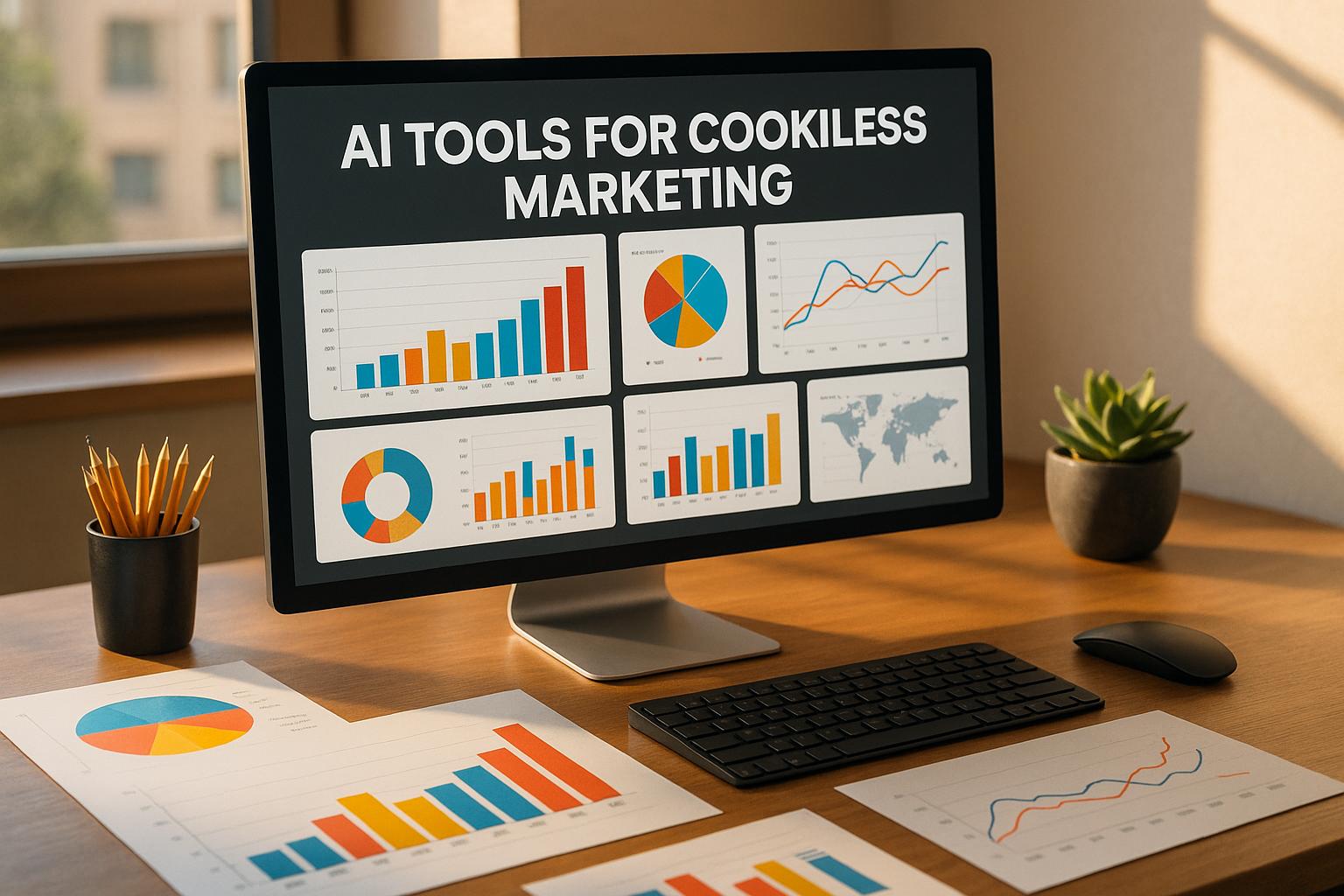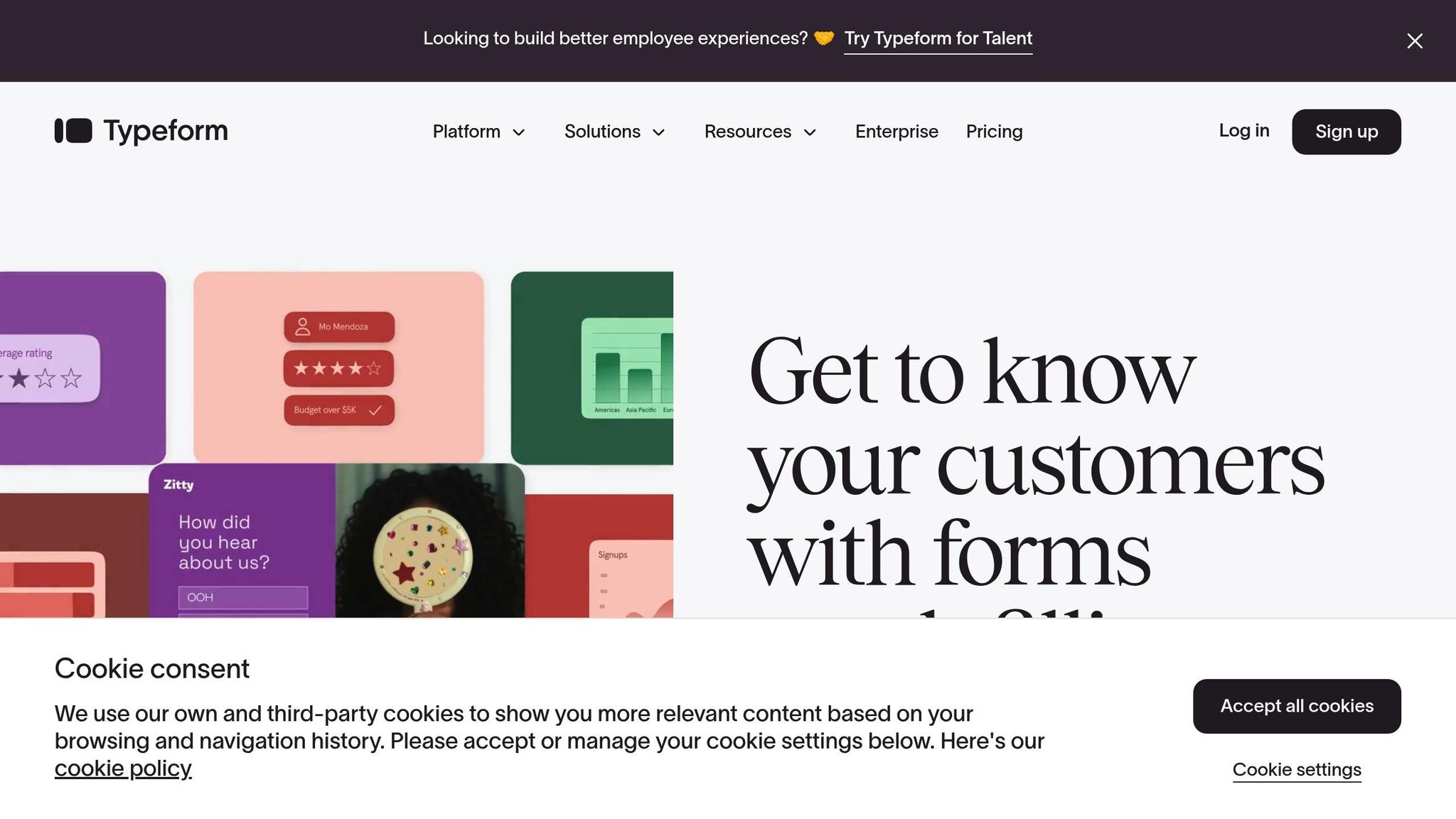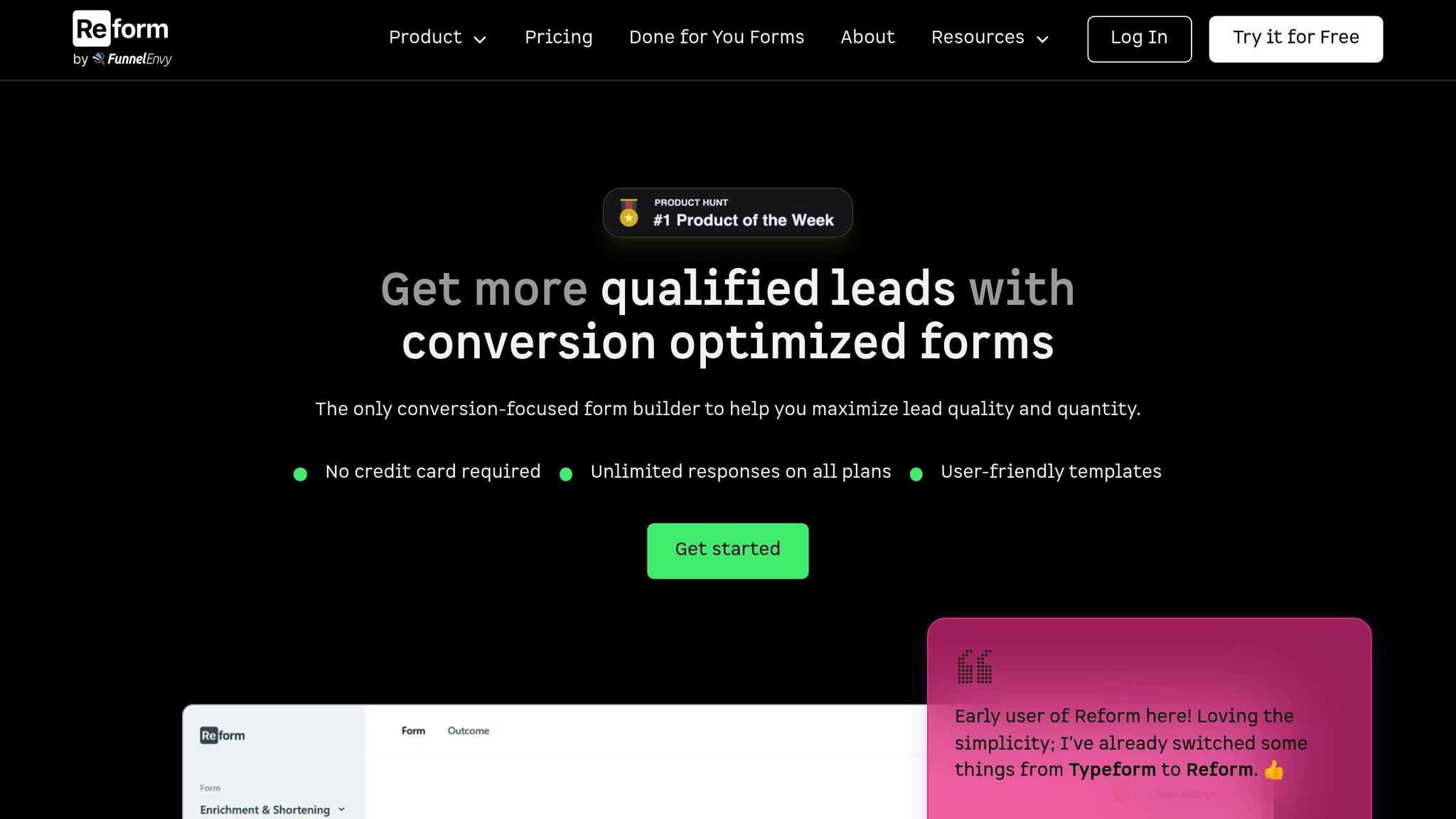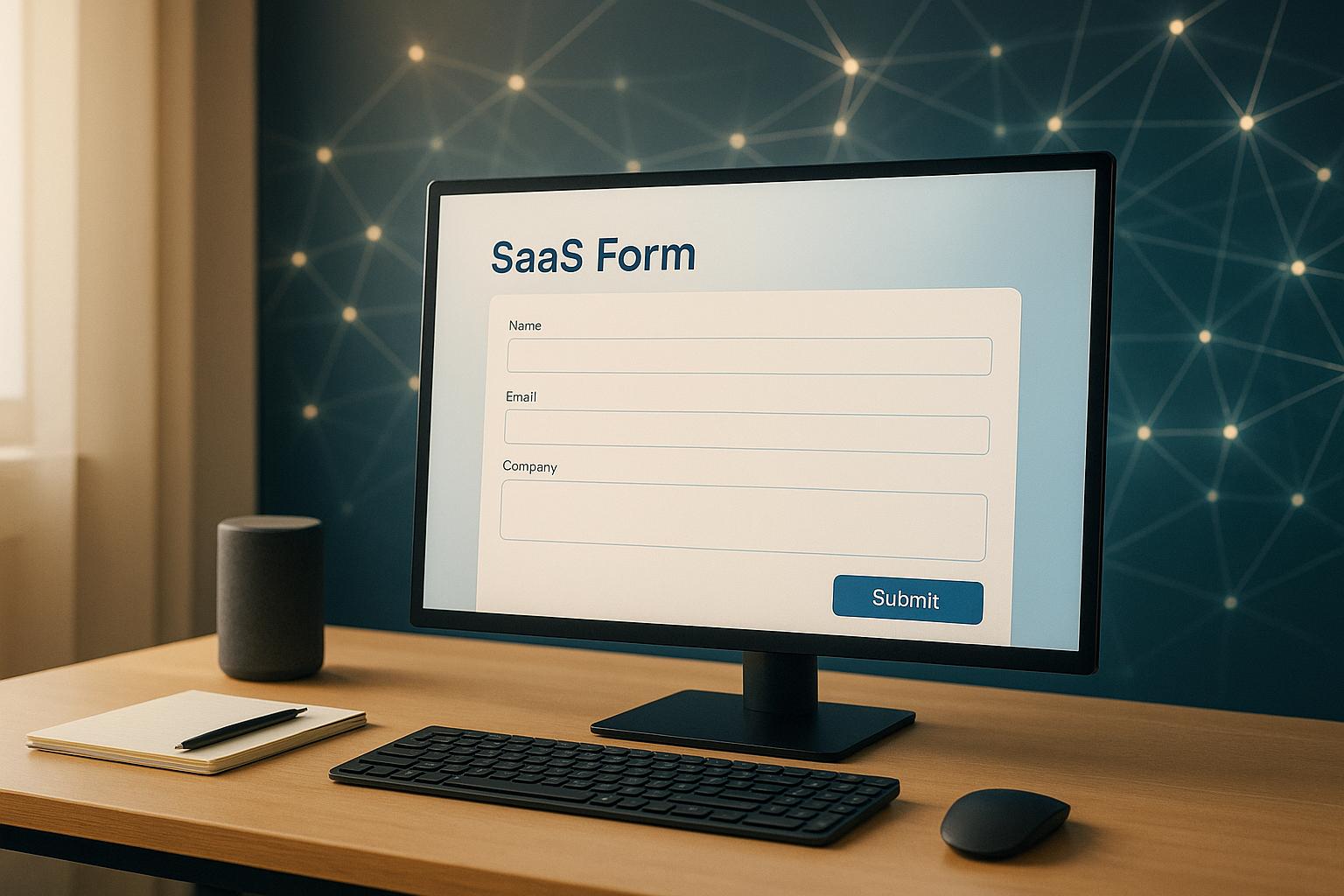AI Tools for Cookieless Marketing

The digital marketing world is shifting fast, and third-party cookies are on their way out. With privacy laws like CCPA and CPRA tightening data rules, and browsers like Chrome joining Safari and Firefox in blocking third-party cookies, marketers need new ways to understand and engage their audiences.
AI offers a solution. By using first-party and zero-party data, AI tools help marketers personalize campaigns, predict customer behavior, and comply with privacy laws - all without relying on invasive tracking. Key strategies include progressive profiling, consent management, and AI-driven segmentation.
Here’s what you need to know:
- First-party and zero-party data: Gather insights directly from customers through interactions like surveys, purchases, and forms.
- AI tools for compliance and personalization: Automate consent management, enrich customer profiles, and predict behavior.
- Platforms like Reform: Privacy-first form builders that simplify data collection and integrate seamlessly with CRMs.
With 88% of marketers optimistic about cookieless strategies and 53% already using AI, the shift is happening now. Businesses that prioritize privacy and leverage AI can build stronger customer relationships while staying ahead in this new era.
How to prepare for a cookieless future | Typeform Webinar

Cookieless Lead Generation Strategies
As third-party cookies are phased out, marketers are shifting gears to embrace direct, privacy-compliant methods for gathering insights. This change doesn't spell the end of effective lead generation. Instead, it opens the door to building stronger, more meaningful connections with audiences by focusing on first-party and zero-party data. With the help of AI, these methods are proving to be even more effective than traditional cookie-based approaches.
Using First-Party and Zero-Party Data
First-party data comes from direct customer interactions, like website visits or purchases, while zero-party data is intentionally shared by users through things like surveys or forms. These methods not only comply with privacy regulations but also help build trust with customers.
AI is revolutionizing how businesses collect and use this data. For example, AI-powered tools in industries like streaming and travel create personalized forms that adapt dynamically, making data collection more engaging and relevant.
The results speak for themselves. Companies using at least 11 advanced first-party data strategies experience a 1.5× increase in revenue, and those with four or more activations see a 2.9× boost. This is especially important when you consider that 60% of all personalization efforts still rely on cookies.
Directly collected data also has a clear edge in quality compared to second- or third-party data sources. Building on these strategies, methods like progressive profiling make lead capture more effective by gradually engaging users.
Progressive Profiling and User Consent
Here’s why progressive profiling works:
- 86% of consumers abandon registration processes that feel too long or intrusive.
- Forms with fewer fields can achieve up to 120% higher conversion rates, and shorter forms can increase completion rates by up to 40%.
- Reducing required fields can lower form abandonment by 10–20%.
By mapping out the customer journey, businesses can identify the best moments to collect data. For instance, start with something simple like an email address, then gather more details over time as trust builds. This approach not only respects privacy but also keeps users engaged.
Consent management is another critical piece of the puzzle, especially in the U.S., where privacy laws vary by state:
| State Privacy Law | Key Requirements |
|---|---|
| California Consumer Privacy Act (CCPA) & California Privacy Rights Act (CPRA) | Requires opt-out for data sale/sharing, and opt-in consent for minors and sensitive data |
| Virginia Consumer Data Protection Act (VCDPA) | Requires opt-in consent for sensitive data processing, along with rights to access, correct, and delete data |
| Colorado Privacy Act (CPA) | Mandates opt-in consent for sensitive data; residents can opt out of data sales and profiling |
Transparency is essential. A striking 90% of consumers are willing to share personal data if it means getting exclusive discounts on products and services they care about. Clear communication about how data will be used builds trust and encourages participation.
Once consent is secured and data is collected gradually, AI steps in to enrich this information and create targeted campaigns.
AI Data Enrichment and Segmentation
AI takes basic customer details and transforms them into rich, detailed profiles - without relying on third-party cookies. This process fills in missing information, corrects errors, and adds valuable context, enabling highly personalized campaigns. For example, AI can analyze unstructured text from reviews, surveys, or emails using techniques like sentiment analysis and keyword extraction, turning raw data into actionable insights.
By segmenting audiences based on factors like company size, job title, interests, location, or behavior, AI helps improve lead quality and boost conversion rates. In fact, 71% of consumers prefer ads that are tailored to their interests. Combining data profiling with AI enrichment makes targeting even more precise, as it integrates firmographic, demographic, psychographic, and location data into a single, cohesive profile.
As Zoran Arsovski, Managing Director at VertoDigital, puts it:
"Once you start doing this, it means that you're moving away from 'just bring me somebody who will fill in a form' to somebody with some attributes and with some qualifications that I'm determining."
― Zoran Arsovski
AI also enables predictive analytics, allowing marketers to anticipate customer needs and deliver the right content at the right time. This not only improves campaign performance but also ensures compliance with privacy laws like GDPR and CCPA. By focusing on first-party and zero-party data, businesses can create detailed customer profiles that support personalization while staying within regulatory boundaries.
These enriched profiles serve as the foundation for more advanced AI-driven lead generation strategies, which will be explored in later sections.
Reform: AI-Powered Tools for Cookieless Marketing

As businesses move away from third-party cookies, Reform steps in to offer a smarter way to capture leads while maintaining strict privacy standards. This no-code form builder combines ease of use with tools designed to boost conversions, giving marketers the edge they need in a cookieless world.
Reform’s approach fits perfectly with the industry’s shift toward collecting first-party data. With 90% of marketers reworking their strategies to focus on capturing zero-party data, platforms like Reform provide the tools necessary to make this transition both seamless and effective.
Privacy-First Features for Lead Capture
Reform’s multi-step forms and conditional routing tackle one of the biggest hurdles in cookieless marketing: gathering meaningful data without overwhelming users. Its progressive profiling features allow businesses to build detailed customer profiles over time, all while respecting user privacy and encouraging higher conversion rates.
"We need to understand how data is flowing, what data we actually need, and to really challenge that - not to collect everything but to get first-party data and build strategies around that."
Reform also prioritizes data quality and compliance with built-in tools like spam prevention, email validation, and real-time analytics. These features not only ensure clean, reliable data but also give marketers instant insights to refine their lead capture strategies - no third-party tracking required.
The platform’s lead enrichment capabilities further enhance data collection by working within privacy guidelines. It adds value to the information users willingly provide, staying true to the principle of direct customer engagement.
"First party data refers to the data we are getting directly from our customers, and this is typically considered one of the most valuable types of data that we can get because it is provided to us, it is reliable, and it is accurate."
These thoughtful features naturally integrate into broader marketing workflows, simplifying the transition to a cookieless future.
Integration with US Marketing Workflows
Reform doesn’t just stop at capturing leads - it ensures that the data flows seamlessly into existing US marketing systems. It connects effortlessly with major CRM platforms and marketing automation tools through native integrations and APIs, making it easy for businesses to incorporate first-party data into their workflows.
The platform also supports webhooks and APIs, allowing integration with internal tools while maintaining current processes. This adaptability is key as companies shift from cookie-based tracking to privacy-first solutions.
Reform offers a variety of embedding options, such as iframes, web components, and headless integrations, so forms can be implemented across multiple digital touchpoints. This flexibility ensures a consistent user experience, no matter where customers interact with the brand.
To top it off, Reform includes A/B testing capabilities, enabling marketers to optimize form performance based on real data. In a cookieless environment, where every lead interaction counts, this feature is invaluable for maximizing conversion rates.
Customization for Accessibility and Branding
Reform understands that effective lead capture isn’t just about functionality - it’s also about trust. The platform’s no-code customization tools let marketers design forms that match their brand identity, creating a seamless and professional experience that encourages users to share their information.
"Reform is a simple, fast forms solution. A no-brainer to reach for anytime I need to (quickly!) throw up a form without hacking around with code. I like that it's customizeable too. Awesome tool!"
For those with advanced needs, Reform offers custom CSS and code support, giving full control over form styling and functionality. This balance ensures that both technical and non-technical users can create polished, effective forms without requiring extensive resources.
Accessibility is another cornerstone of Reform’s design philosophy. By ensuring forms are inclusive and easy to use, the platform reaches a broader audience, maximizing lead generation while demonstrating a commitment to inclusivity.
The results speak for themselves: Reform has delivered a 215% increase in qualified leads for B2B and SaaS companies. This success proves that privacy-conscious data collection can outperform traditional cookie-based methods when done thoughtfully.
As Adelina Peltea, Chief Marketing Officer at Usercentrics, explains:
"Collect the right information at the right time, then we will have higher consent rates and we'll have the trust of the users."
sbb-itb-5f36581
Top AI Tools for Cookieless Marketing
The move away from third-party cookies has opened the door to a new wave of AI-driven marketing tools. These platforms help businesses maintain effective targeting and personalization while respecting user privacy. Here are some key categories of AI tools transforming cookieless marketing.
Customer Data Platforms (CDPs)
Customer Data Platforms (CDPs) have become essential for cookieless marketing strategies. A whopping 77.8% of marketers plan to boost spending on CDPs in the next year. These platforms shine in unifying first-party data from various touchpoints, creating detailed customer profiles without relying on external tracking.
The benefits are clear. For example, 75% of Tealium's customers achieved ROI in less than a year, and 89% saw value within 18 months. MongoDB, using Segment's CDP, reported a 70% revenue increase and a significant boost in registration rates. Similarly, Allergan generated over $400 million in sales thanks to their CDP implementation.
CDPs go beyond just collecting data. They use AI to clean and organize data, remove duplicates, and ensure accuracy. They also offer predictive analytics, helping identify high-value leads and flag at-risk customers. By creating what experts call a "Golden Profile" from consented first-party data, marketers have reported revenue increases of 5% to 15% and improved marketing efficiency by 10% to 30%.
Once this unified data is in place, AI analytics platforms take it to the next level.
AI Analytics and Predictive Modeling
AI-powered analytics tools have completely changed how marketers understand customer behavior in a cookieless world. By analyzing vast amounts of first-party data, these platforms uncover patterns and predict future actions - all while keeping privacy a priority.
For instance, AI models predict sales-ready leads with 77% more accuracy than manual scoring. Companies using these tools also report a 30% drop in customer acquisition costs.
These platforms use advanced algorithms to process behavioral signals, engagement patterns, and interaction data. A great example is Delta Airlines, which used AI to attribute $30 million in ROI directly to their Olympic advertising campaign. This level of precision allows marketers to optimize campaigns and budgets more effectively.
Real-time analysis is another strength of these platforms. They capture insights as user interactions happen, enabling instant adjustments. Additionally, they support multimodal content generation, offering personalized recommendations on content type, messaging, and timing based on customer behavior.
Building on these predictive insights, intent data platforms take things further by identifying sales-ready leads in real time.
Intent Data Platforms and Lead Scoring
Intent data platforms are revolutionizing lead identification and scoring. By analyzing real-time behavioral signals, these tools spot companies and individuals actively researching solutions, allowing for highly targeted outreach - no third-party cookies required.
The results speak for themselves: 87% of marketers say AI has improved their lead scoring. These tools can boost conversion rates by up to 30% and improve sales efficiency by 25%. For example, HubSpot used Leadfeeder to track and score website visitor behavior, resulting in a 25% increase in lead conversions.
These platforms analyze real-time behaviors, such as content consumption and search activity, and integrate seamlessly with CRM systems and marketing automation tools. They automatically update lead scores as new data comes in. Additionally, 87% of marketers report better returns from Account-Based Marketing (ABM) compared to other strategies.
Pricing for these tools varies widely. Leadfeeder starts at $69 per month for up to 500 leads, while enterprise-level tools like MadKudu range from $500 to over $5,000 per month.
| Feature | Traditional Intent Data Tools | Pathmonk |
|---|---|---|
| Intent source | Third-party data or page visits | Real-time behavioral signals on your site |
| Personalization | Limited to CRM workflows or ads | Instant micro-experiences based on AI predictions |
| Tech requirements | Often needs developer support | No-code setup with visual builder |
| Conversion focus | Lead scoring only | Full-funnel optimization to boost conversion rates |
| Visitor privacy | Relies on third-party cookies | Fully cookieless and GDPR-compliant |
| Speed to impact | Long ramp-up times | Immediate results from day one |
The rise of intent data platforms reflects a shift in B2B marketing. With 70% of businesses already using or planning to adopt AI-powered lead scoring tools, the focus is moving from sheer volume to high-quality, sales-ready leads - perfectly aligning with privacy-first marketing.
"Use AI as a starting point, not the final answer. Don't just copy and paste." – Pam Didner, Author and CMO
This advice highlights the importance of combining AI's power with human expertise. These tools deliver valuable insights and automation, but their full potential is unlocked when paired with strategic thinking and creativity.
Preparing for the Cookieless Future with AI
The cookieless future is no longer just a concept - it’s here. By 2024, 72% of businesses are expected to adopt AI, and by 2025, 95% of brand-consumer interactions will be AI-driven. This shift isn’t about whether businesses should adapt; it’s about how fast they can keep up with these sweeping changes.
To navigate this transition, start by taking a hard look at your current reliance on third-party cookies. Conduct an audit to identify the behavioral signals that can be legally captured. This step will help you uncover vulnerabilities in your marketing strategy and highlight opportunities to tap into first-party data sources right away.
One example of this shift is Reform, which prioritizes privacy while capturing high-quality leads. Using its no-code form builder, marketers can gather valuable insights through tools like conditional routing and progressive profiling. This approach ensures customer preferences are respected, building trust at every stage of the interaction.
But identifying the strategy is just the beginning - execution is where the magic happens. Start small by piloting a campaign tailored to a specific customer persona, then scale from there. Equally important is equipping your team with the skills to leverage AI tools effectively. Christina Inge of Harvard Division of Continuing Education emphasizes this point:
"There is a saying going around now - and it is very true - that your job will not be taken by AI. It will be taken by a person who knows how to use AI. So, it is very important for marketers to know how to use AI."
To measure success in this cookieless era, shift your focus to metrics like time-to-response, conversion rates, and content engagement rather than outdated cookie-based benchmarks. The payoff? Companies that personalize their outreach see 40% higher revenue, and personalized emails generate 6× more transactions.
The potential impact of AI is massive. McKinsey estimates generative AI could contribute $4.4 trillion annually to the global economy. For marketers, this means more efficient lead generation, sharper customer segmentation, and better ROI - all while maintaining trust through transparent data practices.
Adapting to a cookieless world is more than a necessity - it’s an opportunity. By rethinking your lead generation process with first-party data and AI, you can create personalized, privacy-respecting customer experiences. Businesses that act now, focusing on ethical data collection and AI-driven insights, will not only stay competitive but also strengthen relationships built on trust.
FAQs
How can AI help marketers create personalized campaigns without relying on third-party cookies?
AI enables marketers to create more personalized campaigns by analyzing first-party data - like customer preferences and purchase history - alongside contextual signals such as location and interaction timing. This combination allows AI to craft tailored recommendations, deliver targeted ads, and produce customized content that connects with individual users - all without relying on third-party cookies.
In addition, these tools prioritize privacy compliance by adhering to ethical data practices. This approach not only helps businesses meet their marketing objectives but also fosters trust in a cookieless digital landscape.
What’s the difference between first-party and zero-party data, and why do they matter in cookieless marketing?
First-party data refers to the information you gather directly from your audience through their interactions with your platforms - things like purchase history, browsing behavior, or email engagement. On the other hand, zero-party data is information customers willingly and intentionally provide, such as through surveys, preference settings, or feedback forms.
In a world moving away from third-party cookies, both of these data types play a crucial role. They not only support privacy and compliance but also help businesses deliver more personalized marketing. By relying on data customers actively share, companies can build trust, strengthen transparency, and create experiences that feel tailored - without needing to depend on third-party tracking.
What is progressive profiling, and how does it improve consent and data collection in a cookieless world?
Progressive profiling is a strategy where user information is collected gradually over time instead of asking for everything at once. By leveraging continuous interactions and tailored prompts, businesses can build trust with users while prioritizing their privacy.
This method aligns with privacy regulations by ensuring data collection is transparent and consent-driven. It also allows marketers to gather more precise and relevant insights, which enhances lead quality and engagement - especially important in today’s cookieless marketing landscape.
Related Blog Posts
Get new content delivered straight to your inbox

The Response
Updates on the Reform platform, insights on optimizing conversion rates, and tips to craft forms that convert.
Drive real results with form optimizations
Tested across hundreds of experiments, our strategies deliver a 215% lift in qualified leads for B2B and SaaS companies.





